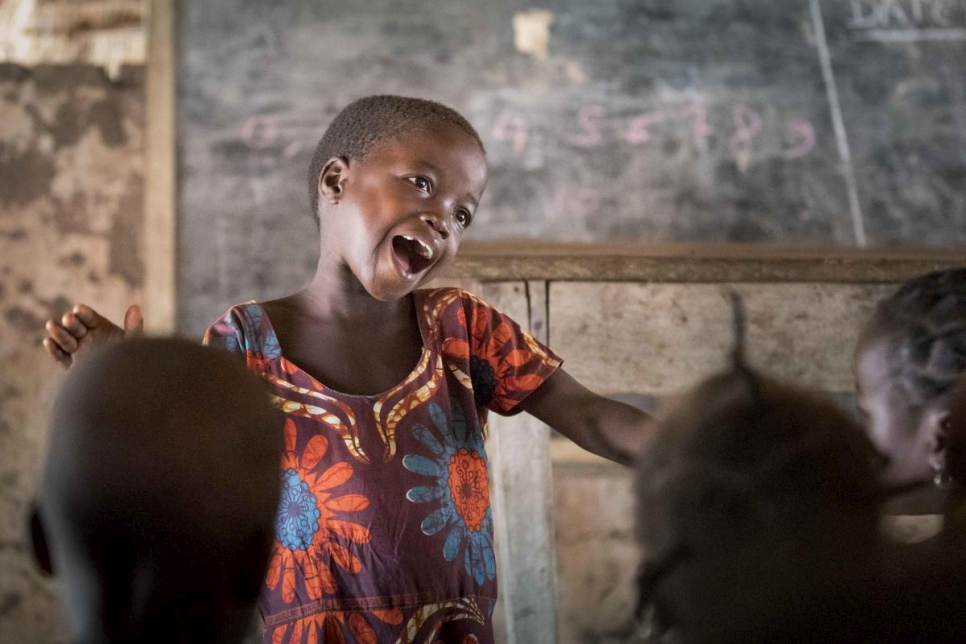UNHCR – Sir Lewis Hamilton Supports UNHCR’s Refugee Education Campaign


Six-year-old Gambolipai Martha leads a singing class with other children in a preschool class at the Mukpandu Refugee Settlement in South Sudan. © UNHCR/Elizabeth Marie Stuart
New York – Seven-time Formula 1 World Champion Sir Lewis Hamilton supports the call to ensure that all refugee children and young people have access to adequate and quality education. This shows that a new report from his UN refugee agency, UNHCR, reveals the urgent need for more international assistance. for refugee students.
In the report All Inclusive: Refugee Education Campaigndata from more than 40 countries show that refugees lag behind their non-refugee peers when it comes to enrolment in all levels of education.
The average primary school enrollment rate for refugee children in the 2020-2021 school year remained broadly stable at 68%. However, enrollment rates have plummeted to 37% at the secondary level, which has historically been difficult for refugee learners to access.
But there was good news at the higher education level. The refugee registration rate is just 6%, an upward trend from just 1% just a few years ago, and there is optimism that the tertiary registration rate target of 15% by 2030 can be achieved. It gives the United Nations Refugee Agency a solid basis.
UNHCR’s annual education report will be published at the Transforming Education Summit at the United Nations General Assembly from 16-19 September as world leaders prepare to discuss the future of learning.
A campaigner for greater equality, equity and diversity in education and motorsport, Lewis said, “I want to lend my voice to the campaign to ensure that refugee children and youth are included in the country’s education system and not left out.” I’m proud of you,” he said. in the margin.
“Education does more than just broaden people’s horizons and provide them with opportunities they otherwise might not have dreamed of. It counteracts the harmful effects of systemic injustice,” he reports. said in the final words of
“We don’t just give young people a better chance at life and help them find purpose and build their future. It’s about the ripple effect of expanding the diversity of positions.”
All Inclusive presents young refugees from Sudan, Ukraine, Kenya and Myanmar. They are aware of the variety of educational opportunities available to them, despite the disruption of displacement and the challenges of adjusting to new and not-so-new situations.
And the United Nations High Commissioner for Refugees, Filippo Grandi, noted in the report that many countries have made significant progress in recent years towards including refugee learners in their formal national education systems. did.
“Now we need to follow these policies and raise substantial and sustained funding to advance the benefits of inclusion,” Grandi said.
“‘Talent is universal, but opportunity is not’ describes the reality of millions of refugee children. We need to close the huge gap between talent and opportunity.”
UNHCR calls for the inclusion of refugees in national education systems in long-term development plans from the beginning of humanitarian emergencies and through protracted displacement situations. Among other things, this includes teacher training and salaries, new infrastructure, adequate and relevant learning materials, safe transport to and from school, access to exams and certifications, and much more towards bridging the digital divide affecting refugees. need support.
“Education is an investment in development, human rights and peace,” Grandi said. “Now is the time to invest in the future of humanity: budding builders, creators and peacemakers.”
“For refugees, it’s an investment in people rebuilding the country when it’s safe to return home.”
Note to editors:
The title of the 2022 UNHCR Refugee Education Report is All Inclusive: Refugee Education CampaignIt’s the story of some of the more than 10 million refugee children of school age under UNHCR’s mandate. It also highlights the desire of refugee youth to continue learning after completing secondary school and the hopes and ambitions of refugee and host community teachers.
Data on refugee registrations and population figures are drawn from UNHCR country work and refer to the 2020-2021 school year. The report also references the latest available data on school enrollment and out-of-school children and adolescents from the UNESCO Institute for Statistics (UIS).
The UNHCR report coincides with the Transformation Education Summit convened by the Secretary-General of the United Nations and to be held during the 77th session of the General Assembly. The summit aims to mobilize action, ambition, solidarity and solutions to transform education from now to 2030.
UNHCR also calculates that by focusing investments in countries with the largest refugee populations, huge gains can be made. Annual costs for all refugee students in low-, lower-middle- and upper-middle-income countries are estimated at US$4.85 billion for 13 years from first year of primary to last year of secondary education, for a total of US$63 billion. It has been. But low- and middle-income countries that host half of their school-age refugees need only 20% of their total. In other words, it would cover her more than 50% of school-age refugee children for a fifth of the total cost.
- Click here to access the report.
- Click here for graphics, images, social media content, translations and other assets.
- For more information on UNHCR’s work in education, please contact Becky Telford. [email protected].
Share on Facebook
share on twitter













